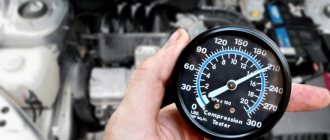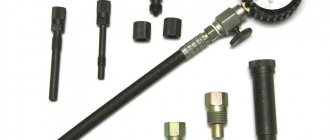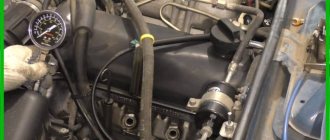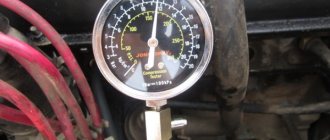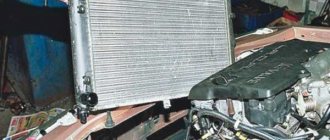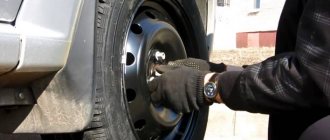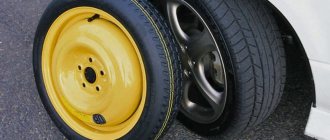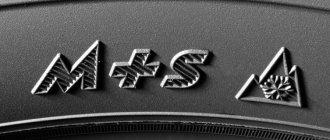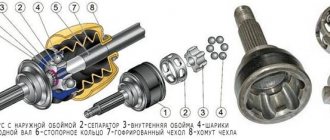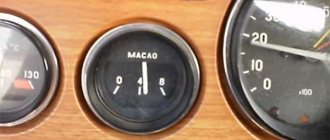How to quickly and accurately determine the condition of the engine? Check the compression in the cylinders! Is the engine running rough, you feel a loss of power, the consumption of engine oil or fuel has increased and the car has become difficult to start in cold weather? All of these problems may be caused by low compression in one or more cylinders.
To ensure that the compression test gives accurate results
Compression depends not only on the technical condition of the engine, but also on the conditions under which it is measured. Make sure that during the check:
- the compression gauge was working properly;
- the engine has been warmed up to operating temperature (up to 90 degrees);
- the throttle valve was fully open;
- spark plugs in all cylinders must be turned out;
- the starter was fully operational;
- the battery was fully charged;
- The engine air filter was clean.
What are the cylinder compression standards for VAZ engines?
Engine specifications must indicate “minimum cylinder compression values.” If you cannot find such data, determine the compression standards yourself using the formula:
| Compression (kgf/cm2) = compression ratio (see technical specifications of internal combustion engine) * coefficient (for VAZ min 1.2, max 1.3) |
- The compression ratio of modern VAZ 21126 and VAZ 21127 engines installed on Granta, Kalina and Priora is 11. We multiply the values using the formula and get the compression standards: 13,2..14,3.
- For the Vesta engine (VAZ-21129) the compression ratio is 10.45, the compression standards will be: 12,5..13,6.
- For Niva (VAZ 21213, 21314) - 11,3..12,2.
If the compression gauge values in all cylinders are within the normal range, this does not mean that everything is fine. Different compression in the cylinders is also bad. It is important that the difference between all readings is minimal. Compare the minimum and maximum compression values in the cylinders. According to technical standards, the difference should be no more than 1 kgf/cm2 or 10% .
High compression in the engine
So, as mentioned above, compression in the power unit can be influenced by a number of factors. Let's start with increased compression. First of all, increased compression usually indicates that there is a problem with the engine. As a rule, the main symptom is unstable engine operation, discoloration of the exhaust and increased oil consumption.
Typically, in many cases, car enthusiasts are faced with so-called “oil” compression, when general engine coking and problems with oil scraper rings lead to excess oil and carbon deposits actually reducing the volume of the combustion chamber. The result is an increase in compression.
In other words, an increase in compression is caused by carbon deposits on the timing valves, the accumulation of coke in the combustion chamber and the occurrence of oil scraper rings. A common cause is also engine overheating, when oil loses its properties due to high temperatures and quickly contaminates the combustion chamber.
Other reasons include the use of additives in the lubrication system, pouring inappropriate or low-quality oil for the engine, constant operation of the engine on low-grade fuel, etc.
One way or another, the accumulation of coke and soot leads to a decrease in the volume of the combustion chamber in which the fuel-air mixture is compressed. Naturally, in this case, when taking measurements, the compression meter will show too high a compression.
Let us also add that deviations from the norm can be caused by incorrect installation of valve timing. Simply put, errors when aligning the pulleys when replacing a timing belt or chain will lead to the drive element jumping several teeth (on an internal combustion engine with a belt) or links (on chain engines) forward or backward.
To avoid possible problems, it is necessary to pay special attention to the location of the marks on the pulleys, engine housing, etc., that is, set the timing drive, and also correctly tension the chain or belt.
Also, the cause of high compression may be a combination of problems with valve stem seals and rings. If, after unscrewing the spark plugs in the cylinders, a clear excess of oil is visible in the form of a thick oil film on the cylinder walls, then this clearly indicates the need to replace the valve seals.
If we summarize the information why increased compression occurred in the engine, the reasons are as follows:
- there is a lot of oil in the engine cylinders (rings are stuck, valve seals are worn, etc.);
- change in the volume of the combustion chamber as a result of the accumulation of deposits and soot, as well as engine overheating and deposits of burnt oil;
Let us also add that compression is affected by air temperature and the condition of the air filter. When taking measurements, it is advisable to disconnect the air filter. It is also important to understand that at many service stations, compression gauges have a large error.
In practice, this requires several repeated measurements on a hot engine, preferably with different and pre-calibrated instruments. There have been cases when at one station the driver’s compression was determined after measurements, for example, 12.5-13, and at another service the readings for all cylinders were already about 16.
To solve the problem of high compression, you can use several available methods. The first is disassembling the engine, physically cleaning the pistons and combustion chamber from carbon deposits, replacing rings, valve stem seals, etc. A cheaper and less effective solution is to decarbonize the engine. In a nutshell, an active cleaner is poured into the combustion chamber for a certain time to remove carbon deposits and coke, after which the deposits washed off the walls and surfaces then burn out while the engine is running.
Reasons why there is no compression in the cylinder
Poor (small) compression in one or all cylinders indicates engine wear. There is an old and simple way to determine why compression has disappeared. You need to pour a tablespoon of engine oil into the spark plug hole and repeat the measurements:
- if the pressure has increased noticeably, it means the piston rings have poor sealing;
- if the pressure has not changed, then there may be several reasons (for example, leaking valves, broken gaskets under the cylinder head, there is a crack or burnout in the walls of the combustion chamber, in the piston bottom).
There is another, more accurate way to find out why compression has disappeared. To do this, you will need to modify the spark plug. We remove the insulator from it, and weld the valve of the car camera to the metal body. Next, set the cylinder piston to the ignition timing position, remove the radiator caps and oil filler neck, screw in the manufactured adapter and pump air into the cylinder using a pump (create pressure in it):
- if air enters the exhaust pipe, it means the exhaust valve is poorly sealed;
- If air goes into the intake manifold, there is a problem with the intake valve.
- if bubbles appear in the expansion tank, then check the cylinder head gasket;
- If there is a hissing sound in the oil filler neck, it means that the piston rings are not properly sealed.
Engine diagnostics using compression measurements in the cylinders allows you to quickly and accurately determine its condition without disassembling, and in some cases will help avoid major repairs of the power unit. Have you ever experienced a lack of pressure in the cylinders? What was the cause of the malfunction? If engine problems persist, check the fuel rail pressure.
Source
Checking compression in the cylinders of the VAZ 2170 Priora
- Repair manuals
- Repair manual for VAZ 2170 (Priora) 2004+.
- Checking compression in cylinders
Compression (pressure at the end of the compression stroke) in the cylinders is the most important indicator for diagnosing the condition of the engine without disassembling it.
Based on its average value and the difference in values in individual cylinders, it is possible to determine with a sufficient degree of accuracy the degree of general wear of parts of the connecting rod and piston group of the engine, and identify malfunctions of this group and parts of the valve mechanism. Compression is checked with a special device - a compression meter, which can now be freely purchased at large auto parts stores.
| Note This is what the compression gauge used to illustrate this book looks like. There are variants of compression gauges in which, instead of a threaded fitting for screwing in, a rubber tip is installed instead of a spark plug. When checking compression, such compression gauges are simply pressed firmly against the spark plug hole. |
| Warning Important conditions for correct readings when checking compression are the serviceability of the starter and its electrical circuits, as well as the full charge of the battery. |
1. Start the engine and warm it up to operating temperature.
2. Reduce the pressure in the power system (see “Reducing fuel pressure in the engine power system” ). After reducing the pressure, do not replace the fuel pump fuse to turn off the fuel pump.
3. Remove the ignition coils and remove all spark plugs (see “Replacing and servicing spark plugs” ).
4. Screw the compression gauge into the spark plug hole of the cylinder being tested.
5. Press the accelerator pedal all the way to fully open the throttle.
6. Turn on the starter and turn the engine crankshaft until the pressure in the cylinder stops increasing. This corresponds to approximately four compression strokes.
| Note To obtain correct compression gauge readings, the crankshaft must rotate at a speed of 180–200 min -1 |
7. After recording the compression gauge readings, set its needle to zero by pressing the air release valve.
| Note For compression meters of a different design, readings can be reset in other ways (in accordance with the instructions for the device). |
8. Repeat steps 4–7 for the remaining cylinders. The pressure must not be lower than 1.0 MPa and should not differ in different cylinders by more than 0.1 MPa. Reduced compression in individual cylinders can result from loose valve seats, damaged cylinder head gaskets, broken or burned piston rings. Reduced compression in all cylinders indicates wear of the piston rings.
9. To find out the reasons for insufficient compression, pour about 20 cm 3 of clean engine oil into the cylinder with reduced compression and measure the compression again. If the compression gauge readings increase, the piston rings are most likely faulty. If the compression value remains unchanged, it means that the valve plates do not fit tightly to the seats or the cylinder head gasket is damaged.
| Helpful advice The cause of insufficient compression can also be determined by supplying compressed air to the cylinder, in which the piston is pre-installed at TDC of the compression stroke. To do this, remove the tip from the compression gauge and attach the compressor hose to it. Insert the tip into the spark plug hole and supply air to the cylinder at a pressure of 0.2–0.3 MPa. To prevent the engine crankshaft from turning, engage the highest gear and brake the vehicle with the parking brake. The release (leakage) of air through the throttle assembly indicates a leak in the intake valve, and through the muffler indicates a leak in the exhaust valve. If the cylinder head gasket is damaged, air will escape through the neck of the expansion tank in the form of bubbles or into the adjacent cylinder, which is detected by a characteristic hissing sound. |
↓ Comments ↓
1. Car structure
1.0 Car structure 1.1 General information about the car 1.2 Passport data 1.3 Car keys 1.4. Controls 1.5. Heating and ventilation of the cabin 1.6 Ensuring a comfortable air temperature in the cabin 1.7. Doors 1.8. Passive safety equipment on the car 1.9. Seats
2. Recommendations for use
2.0 Recommendations for use 2.1. Safety rules and recommendations 2.2 Running in the car 2.3 Operating the car during the warranty period 2.4. Preparing the car for departure
3. Problems along the way
3.0 Malfunctions along the way 3.1. The engine does not start 3.2 Malfunctions of the fuel injection system 3.3 Idle speed has disappeared 3.4. Interruptions in the operation of the 3.5 engine. The car moves jerkily 3.6 The car accelerates poorly 3.7 The engine stalled while driving 3.8. Oil pressure dropped to 3.9. Engine overheating 3.10. The battery does not recharge 3.13. Knocks in the engine 3.16. Wheel puncture
4. Maintenance
4.0 Maintenance 4.1. General provisions 4.2. Inspection work 4.3. Lubrication and filling works 4.4. Diagnostic work 4.5. Repair and adjustment work
5. Engine
5.0 Engine 5.1 Design features 5.2 Possible engine malfunctions, their causes and solutions 5.3 Useful tips 5.4 Checking compression in the cylinders 5.5 Removing and installing the decorative engine casing 5.6 Removing and installing the engine splash guard 5.7 Installing the piston of the first cylinder to the TDC position of the compression stroke 5.8 Replacing the drive belt gas distribution mechanism and tension roller 5.9 Replacing the power unit supports 5.11. Replacing engine seals 5.13. Engine cylinder head 5.15. Engine repair 5.16. Lubrication system 5.17. Cooling system 5.18. Power supply system 5.19. Design Features
6. Transmission
6.0 Transmission 6.1. Clutch 6.2. Gearbox 6.3. Front wheel drives
7. Chassis
7.0 Chassis 7.1. Front suspension 7.2. Rear suspension
8. Steering
8.0 Steering 8.1 Design features 8.2 Possible steering malfunctions, their causes and solutions 8.3. Steering column 8.4. Steering linkage 8.5. Steering gear
9. Brake system
9.0 Brake system 9.1 Design features 9.2 Possible malfunctions of the brake system, their causes and solutions 9.3 Bleeding the brake system hydraulic drive 9.4 Removing and installing the vacuum brake booster 9.5 Replacing the brake pedal axle bushings 9.6. Main brake cylinder 9.7. Front wheel brakes 9.8. Braking mechanisms of the rear wheels 9.9. Pressure regulator 9.10. Brake hoses and tubes 9.11. Parking brake
10. Electrical equipment
10.0 Electrical equipment 10.1 Design features 10.2. Battery 10.3. Mounting block (relays and fuses) 10.4. Generator 10.5. Starter 10.6. Ignition switch (lock) 10.7. Electronic engine control system (ECM) 10.8. Ignition system 10.9. Lighting, light and sound signaling 10.10. Windshield cleaner 10.11. Washer reservoir 10.12. Electric fan of the engine cooling system 10.13. Electric motor of the heating and ventilation system fan 10.15. Cigarette lighter 10.16. Instrument cluster 10.18. Electronic anti-theft remote control system 10.19. Immobilizer 10.21. Replacing sensors and switches
11. Body
11.0 Body 11.1 Design features 11.2 Possible body malfunctions, their causes and solutions 11.3 Removing and installing windshield frame lining 11.4 Removing and installing soundproofing upholstery in the engine compartment 11.5. Removing and installing bumpers 11.6 Removing and installing the fender liner and protective wing cover 11.7 Removing and installing the front fender 11.8 Removing and installing decorative sill trims 11.9. Hood 11.10. Trunk lid 11.11. Doors 11.12. Seats 11.13. Seat belts 11.14. Rear view mirrors 11.15. Interior fittings 11.16. Instrument panel 11.17. Heater 11.20. Body care
12. Applications
12.0 Appendix 12.1 Appendix 1. Tightening torques of threaded connections, Nm 12.2 Appendix 2. Fuels, lubricants and operating fluids 12.3 Appendix 3. Nominal filling volumes 12.4 Appendix 4. Basic data for adjustments and monitoring 12.5 Appendix 5. Spark plugs used on vehicles 12.6 Appendix 6. Lamps used on a car 12.7 Appendix 7. What you need to have in a car 12.8 Appendix 8. Tools used when repairing a car
13. Electrical diagrams
13.0 Electrical Diagrams 13.1 Diagram 1. Instrument Panel Harness Connections 13.2 Diagram 2. Vehicle Front Wire Harness Connections 13.3 Diagram 3. Engine Electronic Control System (ECM) Harness Connections 13.4 Diagram 4. Vehicle Rear Wire Harness Connections 13.5 Diagram 5. Light Harness Connections license plate light 13.6 Diagram 6. Left front door wiring harness connections 13.7 Diagram 7. Right front door wiring harness connections 13.8 Diagram 8. Rear door wiring harness connections
What should be the compression on a Lada Priora 16 valves
Car : Lada Priora. Asks : Ninja Turtle. The essence of the question : at what minimum compression does the engine still run well?
Hello. It feels like the engine has stopped pulling. There is practically no smoke from the exhaust. If there is, then after rain it’s mostly STEAM . We measured the compression - 11.6 , 14 , 12 , 14 . The master said that the first cylinder is not very good, but there should be traction.
Is this normal compression for the Priorovsky 16-valve engine?
Factory compression on Lada Priora
New engines after running in may show 16. This is quite normal.
It is believed that if the compression is less than 13 on a Priorov engine, then this will lead to immediate problems. The engine on the Priora is very high-torque, if the compression is less than 12, then the thrust will no longer be the same. That is, the minimum compression is about 12 atmospheres .
Compression check
Even for cars with a significant mileage, this parameter should not decrease less than 12 atmospheres . In your case there is a problem with the first cylinder, there could be many reasons. If I were you, I would get into the engine with capital only after a serious oil leak or the traction disappears completely.
To check compression on a Priora, the following tools are required:
To measure compression on a 16-valve engine:
- Warm up the engine until it reaches operating temperatures.
You can inspect the condition of the spark plug wells with a flashlight.
Capital is close. But you can drive!
Simple gasket test
If there is insufficient compression, you need to pour a little oil into the cylinder. Then we check again. When increasing the parameters, the problem should be looked for in the piston rings. If nothing changes as a result of the addition, then the head gasket will have to be replaced.
We would recommend checking the compression of the first cylinder in this way.
Source
Arrangement of cylinders on the Prior
Let's see if this is as experienced car owners describe.
Work resource
The working life of the VAZ engine is 200 thousand km. Next, the car owner has to put the engine in for major repairs. The timing belt needs to be checked every 50 thousand kilometers. According to experienced car owners, it is because of a broken circuit that the valves bend.
The engine does not like overheating, which means it does not like the lack of oil. Car owners should carefully monitor the presence of lubricant inside the engine. Without oil, the VAZ21126 will overheat greatly, which means the engine’s already short lifespan will become even shorter.
The working life of the chain may be less than the life of the motor itself. But a broken timing belt takes valves and pistons with it. This disease was not present on VAZ 21124 engines. But such engines were installed only on Standard class Priors, that is, cheap modifications of domestically produced cars.
Similar article Engine temperature indicator and sensor on Lada Grant
Other reasons that affect the life resource:
- fuel quality. The operating book indicates the brand of fuel that the engine requires. Do not underestimate the figure under any circumstances;
- quantity and quality of oil. Experienced mechanics do not recommend pouring or adding lubricant if the car owner changes the oil himself. Do everything strictly according to the level. Such engines love semi-synthetic or fully synthetic lubricants.
Following the rules described above, the motor can last the stated 200 thousand kilometers.
Attention! Pour new oil strictly into the filler neck. You can use a funnel for the procedure.
What to do if the number is unreadable
If the number is not readable, then an examination is ordered. This procedure most often occurs at a post or during a technical inspection. When the inspector cannot read the engine number, he orders an examination.
The number cannot be read for some technical reasons or due to the large amount of rust that has eaten the metal. If the car was often driven in humid areas, in snow with increased salt deposits from ice, then the metal will be susceptible to corrosion. Of course, the embossed numbers cannot be determined.
Attention! During the examination, documents are confiscated. The vehicle is suspected of being stolen, and the code may have been broken. This cannot be avoided, so you just need to wait for the results of the examination and not rush things.
The car owner is invited to the procedure at the appointed time. The process consists of the following steps:
- Experts remove all parts from the engine compartment, which, in their opinion, will interfere with a detailed examination of the VIN code.
- Experts lubricate the remaining code with various means. It must be said right away that the examination is free, but the work of experts must be paid. Therefore, it is necessary to prepare money at the end of the procedure.
- Then the result is photographed. Photos are taken from different angles.
- They write off the vehicle coding from other parts of the car where they can be read.
Similar article VAZ 11186 engine, technical characteristics and service life
If after the procedure they were able to read the numbers, then the car owner can safely go to the MREO. If it fails, then the owner will have to wait half a month until the results are known.
During this time, it will be found out whether this car is listed as stolen, and whether the coding on it has been interrupted. If everything is in order, the documents will be returned to the car owner, and he will continue to drive the Lada Priora.
If the VIN code has rotted naturally, then this will be indicated in the documents. The car owner will be given documents, and the number will be additionally written in the technical passport
It is important to know that after painting with chemicals, the engine number can rot very quickly. Therefore, it needs to be lubricated with lithol. Painting is not recommended under any circumstances. Since the traffic police at the next check will suspect that the numbers have been interrupted. Then the car owner will have to undergo an examination again.
Reasons why there is no compression in the cylinder
Poor (small) compression in one or all cylinders indicates engine wear. There is an old and simple way to determine why compression has disappeared. You need to pour a tablespoon of engine oil into the spark plug hole and repeat the measurements:
- if the pressure has increased noticeably, it means the piston rings have poor sealing;
- if the pressure has not changed, then there may be several reasons (for example, leaking valves, broken gaskets under the cylinder head, there is a crack or burnout in the walls of the combustion chamber, in the piston bottom).
There is another, more accurate way to find out why compression has disappeared. To do this, you will need to modify the spark plug. We remove the insulator from it, and weld the valve of the car camera to the metal body. Next, set the cylinder piston to the ignition timing position, remove the radiator caps and oil filler neck, screw in the manufactured adapter and pump air into the cylinder using a pump (create pressure in it):
- if air enters the exhaust pipe, it means the exhaust valve is poorly sealed;
- If air goes into the intake manifold, there is a problem with the intake valve.
- if bubbles appear in the expansion tank, then check the cylinder head gasket;
- If there is a hissing sound in the oil filler neck, it means that the piston rings are not properly sealed.
Engine diagnostics using compression measurements in the cylinders allows you to quickly and accurately determine its condition without disassembling, and in some cases will help avoid major repairs of the power unit. Have you ever experienced a lack of pressure in the cylinders? What was the cause of the malfunction? If engine problems persist, check the fuel rail pressure.
Compression measurement
A compression test is carried out for a general assessment of the technical condition of the parts of the cylinder-piston assembly and the engine valve mechanism. The check is carried out with the engine warmed up to operating temperature. We increase the pressure in the engine fuel system (see “Replacing the fuel filter”) and do not replace the fuel pump fuse. We unscrew the spark plugs from the cylinder head (see “Checking the condition and replacing the spark plugs”). Disconnect the engine management system wiring harness assembly from the ignition coil wiring harness assembly (see “Engine Removal and Installation”).
Install the compressor tip into the spark plug hole of the cylinder head. We connect the wire terminal to the negative terminal of the battery. We turn the crankshaft with the starter while the accelerator pedal is fully pressed for 2-4 seconds (the pressure gauge should stop rising). We record the pressure gauge readings and relieve the pressure in the compressor. To correctly assess compression, the battery must be fully charged - the crankshaft speed when cranking must be at least 180 min -1. Similarly, we check the compression in other engine cylinders. The compression of a running engine should be between 11.0 and 13.0 bar, and the difference in cylinder readings should not exceed 2.0 bar. To find out the reasons for low compression, pour 10-15 cm 3 of engine oil into the cylinder through the spark plug hole and repeat the measurement. If, upon repeated measurements, the compression increases by more than 2.0 bar, the most likely cause of the malfunction is severe wear, blockage or breakage of the piston rings. If after filling the oil the pressure gauge readings do not increase, the valve discs most likely will not fit into the cylinder head sockets. This can occur if the valve actuator is malfunctioning, or if the valve poppets or seats are severely worn, burned, or damaged. The cause of the malfunction can only be definitively determined after disassembling the engine.
On new Lada Priora engines, the compression in each cylinder must be at least 16 atmospheres. And if, when replacing it, it turns out that in one or more cylinders these readings differ greatly from the maximum, then more thorough diagnostics of the engine is required and identification of the problems that caused such a decrease.
To check the compression on the Priora yourself, we will need:
- Candle head
- Extension
- Ratchet or crank
- Compressor
- Head 10 mm
Reasons for a drop in compression in one cylinder
It also happens that a pressure drop occurs in one of the cylinders, and significantly (in some cases, compression can drop to 3-4 kgf/cm2).
And such diagnostic results are a reason to worry, because there are malfunctions in the power plant.
The reasons for a drop in compression in one of the cylinders above normal may be:
- COMPRESSION RINGS. These elements play one of the most important roles, since their task is to ensure tightness in the piston-cylinder pair. If the rings are damaged (burst) or stuck, they will begin to leak working gases into the sub-piston space, which is why a significant drop in compression occurs;
VALVES. Through these elements, the components of the combustible mixture are admitted and exhaust gases are removed. But during the compression stroke, the valves are closed, which seals the combustion chamber. But if, due to a violation of the combustion processes, the edge of the valve plate and seat are burnt, or the thermal gap is broken, and it turns out to be slightly pressed, then the tightness of the chamber is not maintained, which affects the compression;
PISTON. This element is rarely to blame for a drop in pressure in the cylinder, but there are still situations when the reason lies precisely in it. As a result of the same process changes, the piston crown may burn out. This usually happens due to a violation of the ignition angle. And if the piston burns out, then there will be no tightness;
BLOCK HEAD. Although rare, it does happen that cracks and other defects appear in the combustion chamber, affecting the loss of compression. Also, the head can cause a loss of pressure in some cylinder if it fails due to overheating. Due to changes in geometry, the head in some places simply does not fit tightly to the gasket. Even a simple insufficient tightening of the cylinder head bolts can affect compression;
cylinder head gasket. Due to internal defects or overheating, a breakdown of this gasket may occur. As a result, one of the cylinders is connected to a channel of the cooling or lubrication system, another cylinder (in this case, a strong drop in compression is observed in two cylinders), and the breakdown can also lead out of the engine. Read more about the signs of a broken cylinder head lining.
Also read why the car engine does not pull.
Compression - what is it and what should it be?
Compression is a measure of the maximum pressure in the combustion chamber that the piston can create when it reaches TDC during the compression stroke.
Measuring this indicator gives an idea of the tightness of the chamber, which in turn depends on the condition of a number of elements - the piston and compression rings, valves with seats, head gasket, and the installed thermal gap in the timing belt.
Since the compression measurement technology itself is simple, and the data obtained as a result of its implementation makes it possible to estimate the remaining life of the power plant and identify a number of malfunctions, this diagnostic operation is quite common.
Although car power plants have a common design principle, they are structurally different, which also affects compression indicators.
Each engine has its own specific maximum pressure values in the combustion chambers, which must be indicated in the technical specifications. documentation for the car.
For example, for a VAZ-2106 a compression of 11 kgf/cm2 is considered normal, but for a VAZ-2110 this figure is already 13 kgf/cm2.
Note that when measuring, it is not necessary that the device should show values that correspond to the norm. As engine components wear, compression readings will drop.
Moreover, if they drop below a certain value, this will be a signal of extreme wear of the power plant’s CPG, and the need for major repairs.
Some variation in readings between cylinders is also allowed. However, it should not exceed 1 kgf/cm. sq.
That is, if measurements on a VAZ-2115 showed that the compression in the cylinders was 12 kgf in the 1st, 11 kgf in the 2nd, 12 kgf in the 3rd, 12 kgf in the 4th, then the power plant of the car will be considered to be in working order.
Read more about compression and compression ratio of a diesel engine.
Procedure for checking compression on a 16-valve Priora engine
We will immediately show how to perform this procedure on a 16-valve engine, since on an 8-valve engine everything is done much simpler, and there certainly won’t be any questions.
- The first step is to warm up the engine to operating temperature.
- Remove the top plastic casing
- Unscrew the bolts securing the ignition coils and remove them
- Remove all 4 spark plugs
Now you need to disconnect the power from the coils by disconnecting the wiring harness block, as shown in the photo below in more detail.
Now you can screw the compression gauge fitting into the spark plug hole of the first cylinder, as is clearly shown below.
Now you need to turn the starter while pressing the gas pedal all the way to the floor. At this time, you must either fix the device so that it is securely fastened, or ask an assistant to hold it. It is necessary to turn the starter until the pressure stops increasing.
What and how to measure compression?
As noted above, measuring compression is a simple operation, and it can easily be performed in a garage.
But for this you need a special measuring device - a compression meter.
In fact, this is a regular pressure gauge, equipped with a check valve, as well as an extension cord for ease of diagnostics (the kit may also include attachments for working with different power plants).
In addition to this, the device will also require a spark plug wrench. You won’t be able to diagnose it yourself, so you also need an assistant.
Let's look at how compression measurements are made using the example of a VAZ Kalina car.
The sequence of actions for diagnostics is as follows:
- Warm up the engine to operating temperature;
- We relieve the pressure in the fuel rail (pull out the fuel pump fuse, and then start the engine again so that it produces the remaining gasoline in the rail);
- We remove the tips of the spark plugs, as well as from the ignition module;
- We unscrew all the spark plugs;
- We install a compression gauge in the spark plug hole of the cylinder;
- We ask the assistant to press the gas pedal all the way (this will ensure maximum air supply to the cylinder, which will make the readings more accurate), and then turn on the starter. In this case, to obtain correct data, it is necessary that all 4 strokes have passed in the cylinder being measured, that is, you need to turn the crankshaft at least 2 turns;
- Since the compression meter has a check valve, the device will record the maximum pressure value in the cylinder;
- We write down or remember the obtained pressure value, reset the readings and move on to the next cylinder.
After taking measurements in all cylinders, we compare the data. If the difference in readings does not exceed 1 kgf/cm2, put the spark plugs in place and continue operating the car.
see also
Comments 29
I bought a viburnum with a 126 engine not so long ago, compression 9.6,14,12,14, mileage 127 thousand, I pour 150-200 grams of oil every week, and the question is, is the problem in the valves or does the engine need to be completely rebuilt?
Read more: Tensioner roller VAZ 2105
If the compression differs by more than 1, it means there is a problem with the piston. Maybe the rings are stuck, maybe something else
good compression, don’t listen to anyone) I have one myself and the mileage is 100 thousand) when the rings are stuck, it will be visible to the naked eye from the exhaust fog will go around)
13 is very good for a 126 engine, the compression ratio from the factory is 11! Increased compression with in your case, you need to figure out the cause, fortunately there are few of them! Find a normal motor mechanic.
In 126 engines this is normal. On my Priora the same thing happened even after 92 thousand. mileage I was interested in the mechanics, they said this compression is due to the lightweight piston. And oil consumption in these engines seems to be the norm, although some write, from replacement to replacement. An acquaintance took a new one from the dealership, after the first replacement it began to eat up, and someone drills additional holes in the piston, in the oil scraper groove when replacing the caps. They say it helps.
There shouldn’t be any oil-guzzling at all! There is no need to drill short pistons, because... They are already designed correctly!
Compression is quite good, the only question is that the oil scraper rings could have worn out, due to a good film of oil, that’s why the compression is so good...
13.8 in each cylinder was
Meryl the other day. 16 and further the pressure gauge needle goes off the scale
( 2 ratings, average 4.5 out of 5 )
Motor 126 and 127: working life, differences
These engines on Priora had a displacement of 1.6 liters (or 1596 cm3). Optimal for city sedans, the engine size of the Lada Priora gave a good combination of dynamics and consumption: along with very decent acceleration, fuel consumption does not exceed sky-high numbers. Both engines received good marks, because the car behaved perfectly in the city and on the highway.
In fact, the 126 Priora engine became the first sixteen-valve engine for this model, and the 127 is a modified version, “overclocked” by AvtoVAZ designers. In addition to the same engine displacement, they have other identical characteristics. The in-line type of arrangement of four cylinders provides a simplified design that can be repaired on your own.
The distributed multipoint injection system is involved in creating a good, rich fuel-air mixture (a lean mixture can lead to breakdowns). The cylinder diameter is 82 mm, the piston stroke is 75.6 mm, the compression ratio is 11. The “engines” fall under the Euro 4 standard, they are powered by gasoline with an octane rating of 95.
The 126 engine for the Priora received the following characteristics: 98 hp. (72 kW at 5600 rpm), acceleration to 100 km/h in 11.5 seconds (with manual transmission), city consumption 9.1 l - 100 km (manual transmission), maximum torque - 145 Nm.
The 127 engine for the Priora was upgraded to the following figures: 106 hp. (78 kW at 5800 rpm), acceleration to 100 km/h in 11.5 seconds (with manual transmission), city consumption 8.9 liters per 100 km (with manual transmission), maximum torque – 148 Nm.
The difference may not seem so noticeable, but this is a very small but strong step in design on the part of AvtoVAZ (this is where the change to sixteen-valve “engines” with a volume of 1.6 liters ended). For a car of the Lada Priora class, the engine power was sufficient.
In the same block it is necessary to say about the operating temperature. An absolutely normal operating temperature is considered to be between 90 and 95 degrees Celsius. Further, when the car is being pushed in a traffic jam, is basking in the sun, or for some other reason, but can still work - from 97 to 110 degrees. The engine is slow in places and wears out a lot, but you can still get to your destination. A temperature below 90 degrees is a direct sign indicating that the car has not yet warmed up, and it is better to wait in place until the arrow points to the coveted 80-90 mark.
Operating a car at temperatures above 110 degrees is dangerous because the service life of the engine is noticeably reduced - hot parts undergo very severe wear, overcoming the force of friction.
In general, the service life of the Lada Priora engine with a normal driving style and careful treatment is 200,000 km - after this mark the time comes when the “engine” requires major repairs. AvtoVAZ mentioned the timing belt separately as a recommendation, saying that it needs to be checked every 100,000 km (many car enthusiasts talk about the figure of 50,000 km).
All Lada engines have a problem, and it is related to the valves, which will be discussed further.
Signs of the need for internal combustion engine repair
The reasons why the operation of the engine is disrupted are arranged in a small list, starting with refusal to start and ending with floating idle speed (this problem was removed on the 127 “engine”). Not all breakdowns end in capital damage - sometimes it’s enough to add oil, sometimes it’s enough to adjust the ECU settings.
Compression reduction
A decrease in cylinder compression below 16 atmospheres is a bad sign. Such a high limit corresponds to a compression ratio of 11.
If the compression decreases (or vice versa increases), then the “engine” will have to be rebuilt.
Knocks in the engine
Engine knocks can come from several points. These could be hydraulic compressors, timing belt rollers or pins. The knocking noise could also be caused by low oil level. The answer to the question will be given by a thorough detailed inspection of all parts of the unit and checking the oil level.
Blue smoke from the exhaust pipe
The blue smoke that comes from the exhaust pipe appears when oil enters the combustion chamber. It can leak either from the valves or from under the piston. The result is the same: the oil is eaten up and blue smoke pours out of the chimney. Once the leak is located, half the problem will already be solved.
Troit motor
Sometimes in the cold the engine may stall - don’t be alarmed by this, because it may simply be one of the spark plugs that fails. In this case, we advise you to simply restart the engine and it will stop running.
How much does it cost to overhaul a Priora engine - average price
Self-repair of a Priora engine with 16 valves costs an average of 16-20 thousand rubles. The cost depends on the severity of the breakdown and may be lower or higher than this average range. Repairing a Priora engine can be entrusted to the wrong hands, but then you will have to pay for the work - sometimes the cost of repairs reaches as much as 40 thousand rubles.
This is an unreasonably inflated figure, because, as practice shows, you can rebuild the engine on a Priora, working at a moderate pace, in just three days - and three days of work is definitely not worth that kind of money. Don’t be afraid of not being able to cope - your Lada is easy to repair, and using the advice and “tutorials”, you will conquer even such a task that is impossible at first glance.
Video review of compression measurements on a Priora 16-cl.
In this case, a review is shown using the example of the 11194th engine, but there is absolutely no difference when performing this procedure.
I think that from the presented video review everything became more or less clear.
How to quickly and accurately determine the condition of the engine? Check the compression in the cylinders! Is the engine running rough, you feel a loss of power, the consumption of engine oil or fuel has increased and the car has become difficult to start in cold weather? All of these problems may be caused by low compression in one or more cylinders.
How to determine why the compression in the cylinder has dropped?
If it is determined that in one of the cylinders the compression is below normal, it is necessary to determine what exactly caused the problem.
To more accurately determine why the pressure in the cylinder dropped, you should carry out several simple procedures:
- Pour 10-15 g into the cylinder with reduced compression. engine oil, then measure again. If the indicators have improved, it means that the reason for the fall lies in the rings (they are stuck or one of them has burst);
- Remove the valve cover and check the valve clearances on the required cylinder;
- Carefully inspect the engine at the junction of the head and the block. If there is a gasket breakdown leading outward, oil leaks will be visible;
- Pull out the dipstick and assess the condition of the oil. If it is very blackened and a burning smell is clearly visible, then this may indicate a breakdown of the gasket, in which the cylinder is connected to the oil channel;
- Assemble the engine and start it. Then you should inspect the expansion tank of the cooling system. If escaping air bubbles are visible in it, this will signal the connection of the cylinder with the channel of the cooling system. Additionally, you can put your hand on the exhaust pipe while the engine is running. If small sweet-tasting drops remain on the palm, this will indicate that coolant has entered the cylinder, that is, there is a breakdown.
If all the procedures carried out did not produce results, that is, after filling the oil, the compression did not increase, the thermal clearances are normal and there are no prerequisites for a breakdown of the cylinder head gasket, then the reason lies in the piston, valves or cylinder head.
But to make sure of this, you will have to remove the block head.
What compression should be on Priore
Priora what should be the compression
Rules (changed on April 14, 2013): 1) Respect the opinions of others as you respect your own! 2) Do not create similar topics, i.e.
K. Among a bunch of such topics, it’s difficult to find something useful! (secondary topics will be deleted!) 3) Do not flood, try to answer the questions posed clearly and on topic. 4) Mat is prohibited! Up to the exclusion of the user from the community.
5) Commercial activities are permitted with the consent of the administration. And now attention: 6) If we want to sell something, we write here: 7) We want to buy something for the Priora, then we ask here: Xenon Tires and wheels Auto Sound Suspension 9) Forum here we write what you did with the Priora, write what you want enlighten the people, boast! =) (for example: bought new light bulbs, lowered the car, painted the reflectors, cleaned the ashtray, etc.
) In the title, indicate what exactly was done. It is advisable to insert text with a short description and a link to the logbook. Entries with links to the logbook without the main text will be deleted! 10) Blog here we ask questions that arose during the operation of the Priors or if we want to get advice on what and how to do! (for example: how to lower a Priora, how to change a light bulb in the glove box, how to make a Shumka, and so on), or maybe they just decided to share the result of how they solved some serious problem. If any problem arises, it is advisable to describe it and add a video or photo. Entries with reference to the logbook will be deleted! Entries with advice on appearance will also be deleted; after all, the blog is for urgent and important issues.
2 Compression measurement on 16-valve Kalina and Priora
Compression on Prior
During the previous measurement (1000 km ago) on a cold engine, I measured 18 bar in each cylinder. When completely...
Compression measurement on 16-valve Kalina and Priora
We measure compression
There are 11194 cylinders in the engine that is installed on Kalina, taken for disassembly.
For example: what color should I buy wheels? what color should I paint it? etc. Post in your logbooks and ask your subscribers.
Use the search, it often happens that such an entry already exists! Repeated topics will be deleted! 11) When creating topics, it is recommended to briefly indicate the essence of the problem in the title (3-5 words are usually enough) and also adhere to basic spelling rules when writing any messages. Anyone who has a problem with the Russian language, please leave a message at the end of the message for the moderators with a request to correct it. Topics like Help, Problem, Tell me what to do will be deleted, as well as topics in which the topic is written without basic punctuation marks, capital letters, etc.
D. Let's respect ourselves and others! Carefully watch where and what you write so that you don’t end up with a bunch of entries and the community doesn’t become cluttered! The moderators will send you a personal message about your violations of the community rules. Guys, no offense, repeated violation of the rules will lead to exclusion from the community. In DRIVE2 communities it is strictly forbidden to: insult interlocutors, use any kind of curse words (including disguised ones), flood, publish advertising messages or any kind of announcements, write in capital letters, translitom or in a foreign language, propagandize violence, national or religious strife. Violations of these simple rules may result in either the blocking of the violator’s account or the closure of the community if its organizers do not act. You can read more about the Site Rules. Thank you for your attention and understanding.
What should be the compression on a Lada Priora 16 valves
Car : Lada Priora. Asks : Ninja Turtle. The essence of the question : at what minimum compression does the engine still run well? Hello. It feels like the engine has stopped pulling. There is practically no smoke from the exhaust. If there is, then after rain it’s mostly STEAM . We measured the compression - 11.6 , 14 , 12 , 14 .
The master said that the first cylinder is not very good, but there should be traction. Is this normal compression for the Priorovsky 16-valve engine?
To ensure that the compression test gives accurate results
Compression depends not only on the technical condition of the engine, but also on the conditions under which it is measured. Make sure that during the check:
- the compression gauge was working properly;
- the engine has been warmed up to operating temperature (up to 90 degrees);
- the throttle valve was fully open;
- spark plugs in all cylinders must be turned out;
- the starter was fully operational;
- the battery was fully charged;
- The engine air filter was clean.
What are the cylinder compression standards for VAZ engines?
Engine specifications must indicate “minimum cylinder compression values.” If you cannot find such data, determine the compression standards yourself using the formula:
| Compression (kgf/cm2) = compression ratio (see technical specifications of internal combustion engine) * coefficient (for VAZ min 1.2, max 1.3) |
If the compression gauge values in all cylinders are within the normal range, this does not mean that everything is fine. Different compression in the cylinders is also bad. It is important that the difference between all readings is minimal. Compare the minimum and maximum compression values in the cylinders. According to technical standards, the difference should be no more than 1 kgf/cm2 or 10% .
Source
